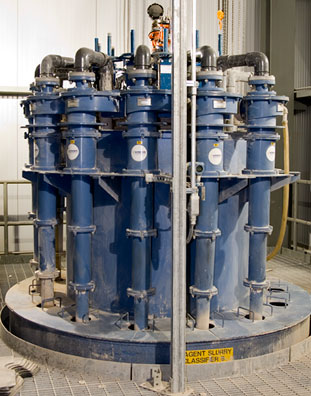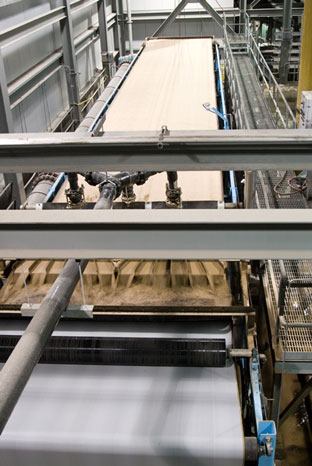The B&W Learning Center
Leading the world in clean power production technology
Wet FGD System

Reagent Preparation and Dewatering in a Wet FGD System
When SO2 removal is increased by equipment upgrades and/or when burning higher sulfur coals, the amount of wet FGD byproduct will increase. Wet FGD systems that use natural oxidation could be potentially impacted from this increased demand on the system. As a result, the disposal pond may reach its capacity. Additionally, the use of disposal ponds may not be allowed by future regulations.
If limestone consumption must be increased to improve SO2 removal, the reagent preparation and dewatering systems may be undersized. In most cases, higher SO2 removal requires a finer grind than what older systems were originally designed to achieve. The standard grind on modern wet FGD systems is 95% passing through a 325 mesh.
The components of some existing milling systems can potentially be upgraded to handle the new quantity and grinding requirements. Optimizing the grind of the limestone milling system can have a significant positive impact on limestone utilization. However, it is typically not possible to vary the speed of the mill to increase or decrease its capacity.
Early generation wet FGD systems used thickeners for primary dewatering and rotary drum filters for secondary dewatering. Modern wet FGD systems have replaced thickeners with hydroclones which can achieve up to 55% solids, compared to 35 to 45% for thickeners. Thickeners also require a much larger plant footprint. Increased moisture removal from the hydroclones can reduce the required size of the vacuum filters.
Thickeners are prone to maintenance problems. The rakes tend to stick and the large mechanical equipment can be expensive to maintain or replace. Also, a conversion to forced oxidation can make thickeners difficult to operate because of the rapid settling of gypsum in the center well of the thickener.
Hydroclones require minimal maintenance with little downtime because of the use of spares. The use of hydroclones in forced oxidized systems is a proven technology. Figure 1 shows a hydroclone cluster in a wet FGD application.
Many older wet FGD systems use rotary drum filters. These filters may not have the capacity to handle increased SO2 removal and the resulting greater amount of byproduct from the absorber. The existing rotary drum filters must be assessed to determine if it can handle the increased demand. One possible solution to handle this increased demand is to increase the amount of time per day that the rotary drum filter operates. Worn parts of the system may need replaced to ensure adequate reliability. In some cases, replacement of the existing drum filters may be required. New generation rotary drum filter technology can achieve levels of 10% moisture or better.
The majority of new wet FGD systems use vacuum belt filters (Figure 2) to reach moisture levels of less than 10%. Decreased gypsum moisture levels may allow for gypsum sales to wallboard and cement companies, or a decrease in landfill transportation costs.

Fig. 2 Vacuum belt filter.